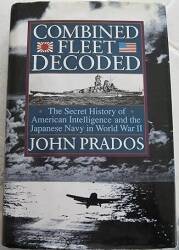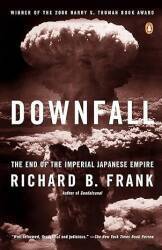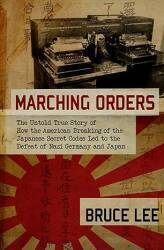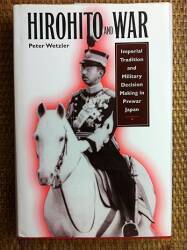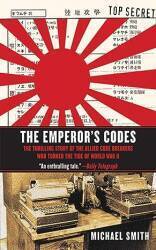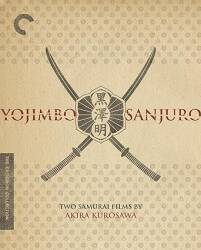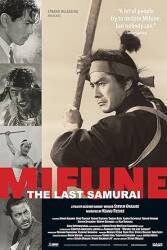
Naval Bunker
Sakurajima Suicide Torpedo Base
Kagoshima Bay is a large, well-protected harbor.
Rail and road connect north across Kyūshū.
It's an obvious destination for a naval landing.
Japan's leaders realized that
the country was losing World War II.
However, those in control believed that
the Emperor was directly descended from the creator gods.
Surrender and even negotiations were unthinkable.
Desperate defense to the very end would kill
millions of Japanese people,
some through direct involvement in the conflict
and many more through the accompanying famine.
But if that's what it took to preserve the Emperor's rule,
that was acceptable to the Japanese leadership.
There's a naval bunker along the shoreline
close to the ferry terminal on Sakurajima.
It was built as a base for suicide missions
with manned torpedoes.
Not much is visible, but it's certainly easy to visit.
And whose vacation doesn't include visits to
manned suicide torpedo bases?
Let's take a look!
Arriving on Sakurajima
Below is the view from on board as the ferry docks at Sakurajima. Looking north along the shoreline, the torpedo bunker is along the road a short distance beyond the buildings.

I had spotted the recent concrete arch and sign from the bus while riding down from the observation platform part-way up the volcano. The bus drops you off at the ferry terminal, and I walked back. The ferry between Sakurajima and Kagoshima City costs just ¥ 200, runs every 10 minutes through the day, and takes just 15 minutes each way. So, it's easy to return to Sakurajima for another visit.

A network of tunnels is cut into the hillside. Chambers are marked for storing and working on torpedoes. Rails once led down across today's road into the water.
These torpedoes weren't meant to be loaded onto ships and submarines. They were to be launched into the bay with suicide pilots on one-way missions in Kagoshima Bay and even a short distance into the ocean.
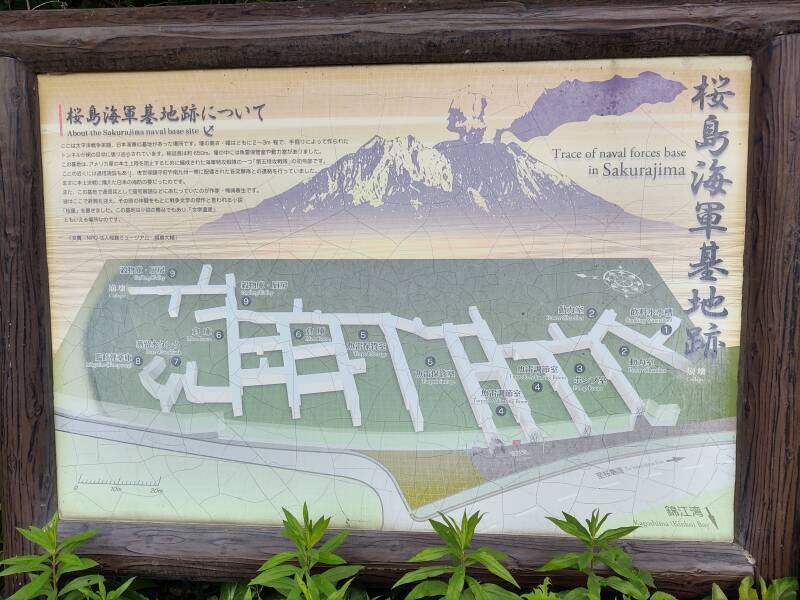
Google Translate for images tells me that the Japanese text in the above image reads:
About Sakurajima Naval Base Ruins
This is where the Japanese Navy base was located at the end of the Pacific War. The trenches are approximately 2 to 3 meters high and wide, and are made up of a network of hand-dug tunnels. The total length is approximately 650m. Inside the trench was a torpedo storage room and a power room. This base is the headquarters of the 5th Special Attack Squadron, one of the naval special attack squadrons formed to prevent American troops from landing on the mainland.
There was also a communication facility near here, which was used to communicate with the Sasebo Naval Base and the various assault units deployed in the southern Kyūshū area. It was truly the cornerstone of Japan's coastal defense in preparation for a decisive battle on the mainland.
Also, the writer Haruo Umezaki worked as a communications soldier at this base, helping to decipher codes. It was here that the war ended, and he wrote the novel "Sakurajima", which is said to be a masterpiece of war literature, based on his experiences at that time. This base is also the setting for a novel, and is a place that can be called a "literary heritage".
(Written by Daisuke Fukushima, NPO Sakurajima Museum)
"Sakurajima" by Haruo Umezaki is actually a short story, not a novel. It was included in an English-language collection of Japanese short stories about the war. Umezaki was drafted into the Imperial Japanese Navy and served in signals and ciphers. His story described hoping to survive to the end of the war without having to die for the Emperor, while surrounded by naïve young men training for suicide.
"Special Attack" is the tip-off here.
The Tokubetsu Kōgeki Tai or Special Attack Units of the Imperial Japanese Navy and Imperial Japanese Army were used for suicide missions. These included the Kamakazi aircraft, several types of suicide boats and torpedoes, and suicide divers carrying mines.
The Kaiten or "Heaven-Shaker" was a suicide crewed torpedo. It was designed to be launched from the deck of a submarine or surface ship, or from a coastal bunker like this one. Over 300 of the Type 1 Kaiten were built, and over 100 were deployed on suicide missions with 1,550 kg warheads. They had a range of up to 78 kilometers. Prototypes of Types 2, 4, 5, 6, and 10 were built, but never went into production before the end of the war.
This was a Kaiten base. But unlike many similar installations around the outer shores of the Home Islands, it didn't become fully operational before the end of the war.
The Kairyū or "Sea Dragon" two-man midget submarine carried two torpedoes and a 600 kg explosive charge for suicide missions. Most of the 210 Kairyū built by the end of the war were deployed at Yokosuka, at the entrance to Tōkyō Bay. None of them ever launched on a mission.
The Shin'yō' or "Sea Quake" was a suicide boat. They were piloted by one man at a speed of about 30 knots, with a 300 kilogram bow-mounted explosive charge. 6,197 were produced for the Imperial Japanese Navy. Another 3,000 of the Maru-Ni variant that carried depth charges were built for the Imperial Japanese Army. Some were deployed during the 1944–1945 Philippines Campaign, but most remained in the Home Islands for defense against a U.S. invasion.
The Fukuryū or "Crouching Dragons" were suicide divers. They wore a diving suit and carried a 15 kg explosive charge on a 5 m bamboo pole. They didn't swim. They wore 9 kilograms of lead weights and carried two compressed air tanks. They were expected to walk at a depth of 5–7 meters for about six hours, marching across the sea floor to stick their explosive charge into a ship.
Below is the diagram of the facility. This is on a sign next to the concrete arch at one of the foor doorways. You can see the arch and the sign in red on the diagram, next to one of the four entrances. As usual in Japan, a map is drawn so that the top is the direction ahead of you as you face the sign, an excellent design once you understand that's the way almost all maps are presented.
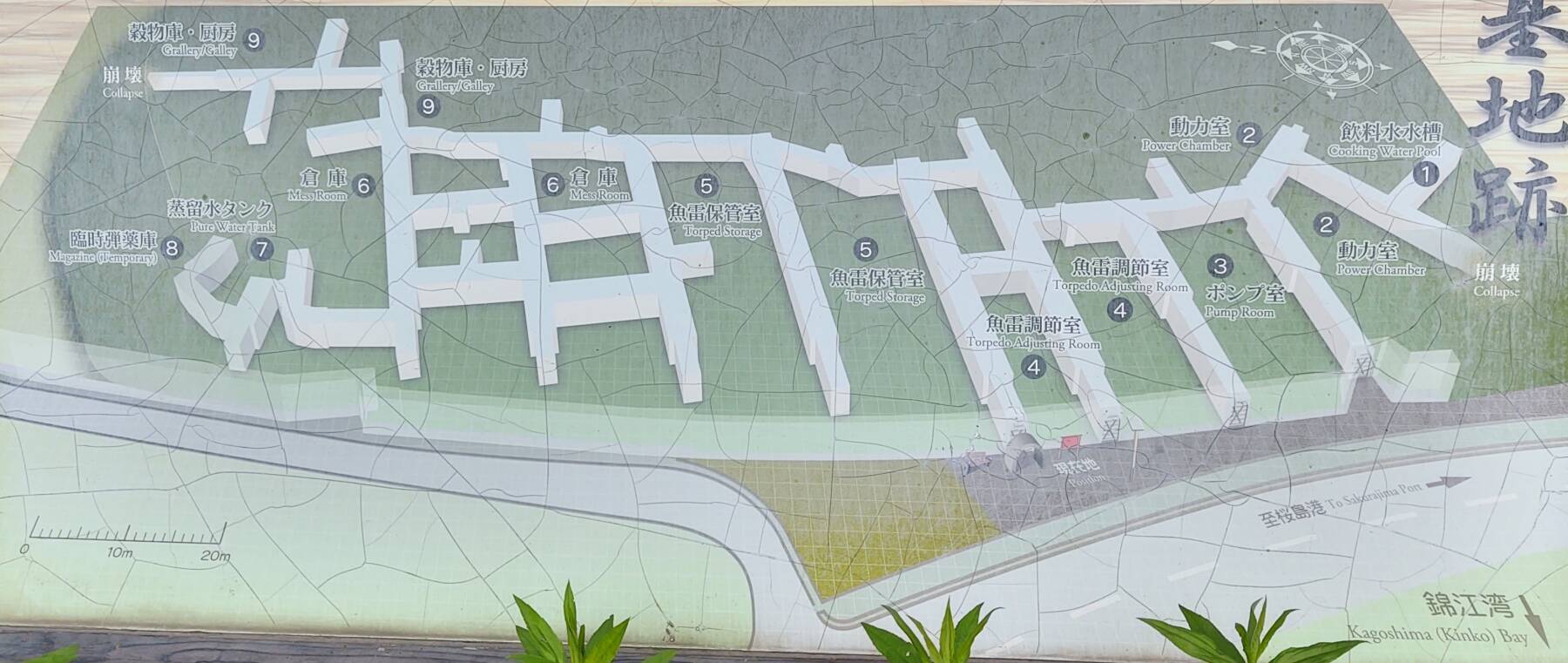
The Kaiten suicide torpedo was 14.75 meters long. I believe that the chambers marked as #4 above should be "torpedo assembly room" instead of "adjusting". There would be no way to move an object 14.75 meters long by one meter in diameter through those right-angle intersections of narrow passageways.

The torpedo afterbody would be the largest component. Then the forward section with torpedo subsystems and the connecting section with the pilot's position would be two more major components. Those three sections could probably just barely be moved through the underground passages. The warheads were probably stored separately for safety, being attached during the final assembly.
An oxygen rebreather had been developed in 1939, and the British, German, and Italian frogmen used them throughout World War II. In 1942, Jacques-Yves Cousteau and Émile Gagnan developed an open-circuit system with a demand regulator and high-pressure tanks.
However, the Kaiten used compressed air to fill the pilot's compartment. Possibly what's labeled "steering air" in the above diagram from Wikipedia, or possibly the pilot's compartment was filled at launch time and that was considered adequate for the one-way mission of limited time. The relatively few descriptions of these suicide weapons report that they were prone to leaking seawater into the engine and pilot compartments. So, the pilots didn't use any breathing apparatus. They just sat in a dank, pressurized but leaking compartment, steering a suicide torpedo to certain death.
The 78-kilometer range could take a Kaiten all the way down Kagoshima Bay and a short distance out into the East China Sea.
Let's See What's Visible
This is the door with the modern concrete arch standing outside. This leads into a passage labeled as "Torpedo Adjusting Room" on the sign, surely for assembly instead. A newly assembled torpedo would be rolled through this doorway and down a short set of rails into the bay.
The concrete blocks and wooden door are recent additions. Watch out for snakes. The mamushi is a venomous pit viper found throughout Japan. It mostly eats rodents so it tends to be found around farmland, but this looks pretty snakey.

Looking in through the door, I could see some recently added concrete block walls.
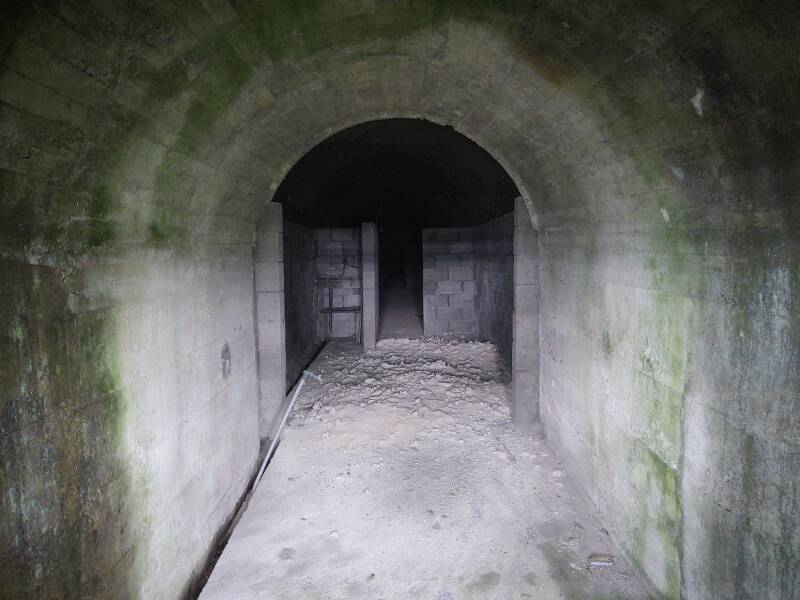
The door was locked, and looked as if it hadn't been unlocked for quite a while. Most visitors to Sakurajima are there for the volcano and the onsen or hot bath, and not for the suicide torpedoes.
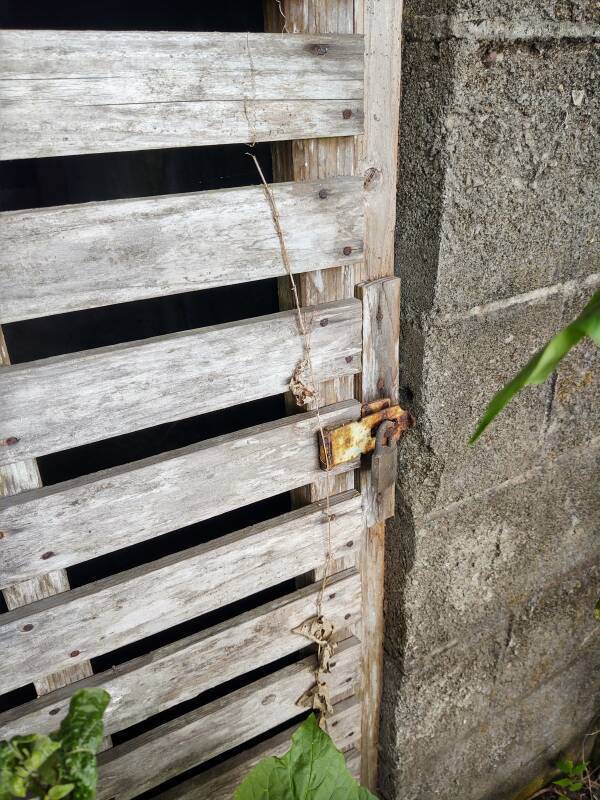
The next two doorways to the right were completely closed off with recent concrete block installations. Here's the first of those:
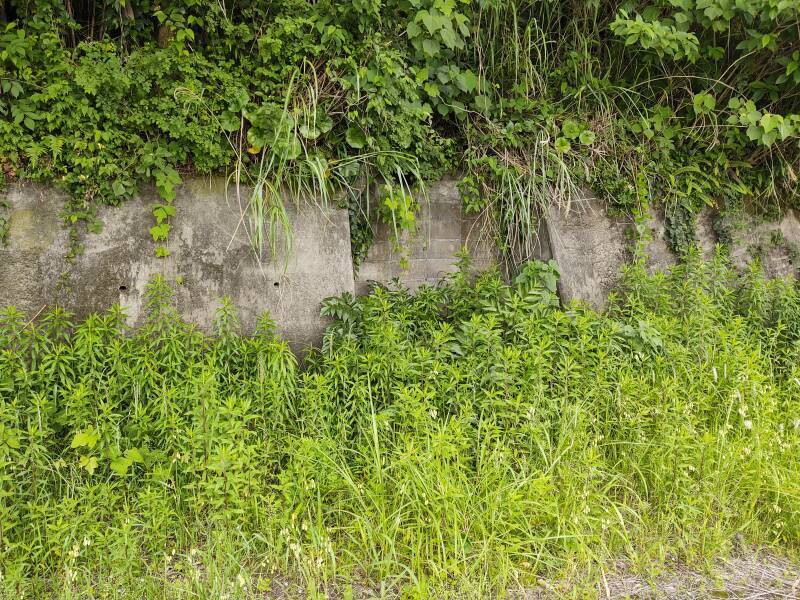
And the second:
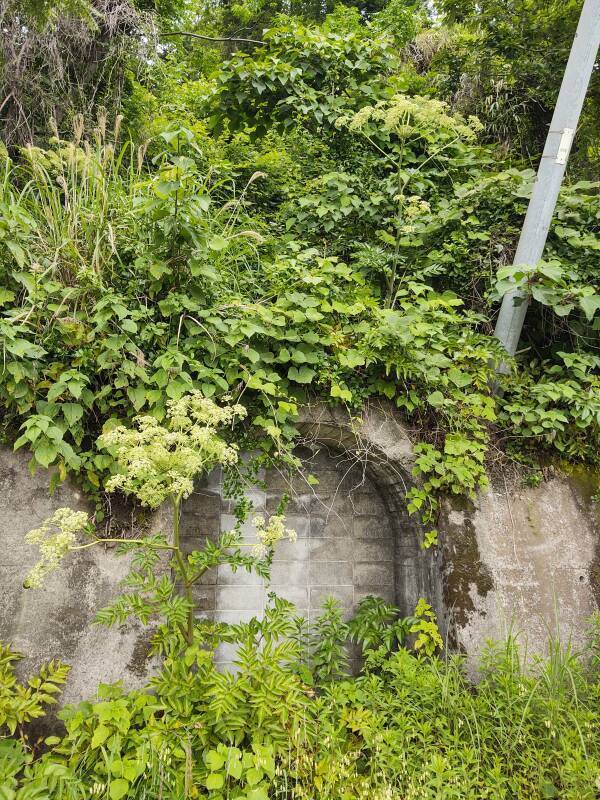
The fourth and final door, snakier yet, was closed off with concrete blocks but with gaps I could look through.

It's even snakier, if one were to allow that to limit exploration.
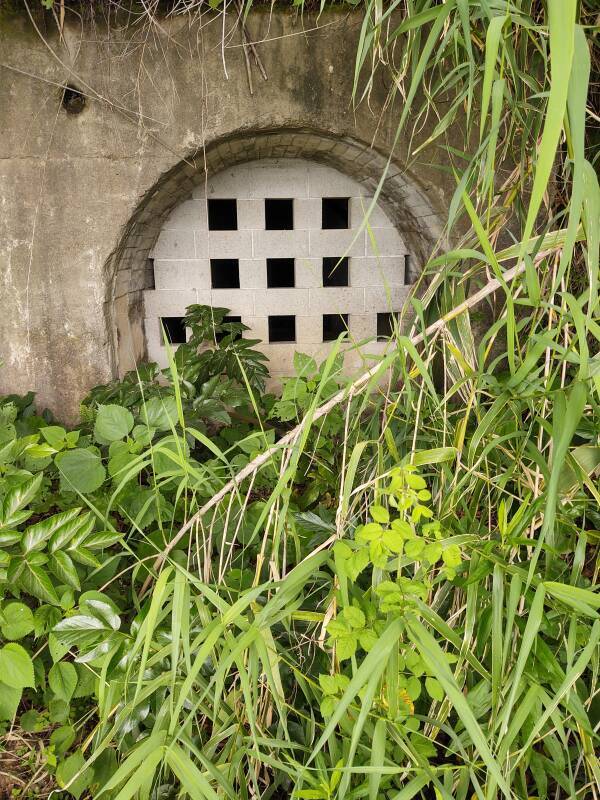
There were coils of wire back in the tunnel. The diagram on the sign showed this passageway leading to the Power Chamber.
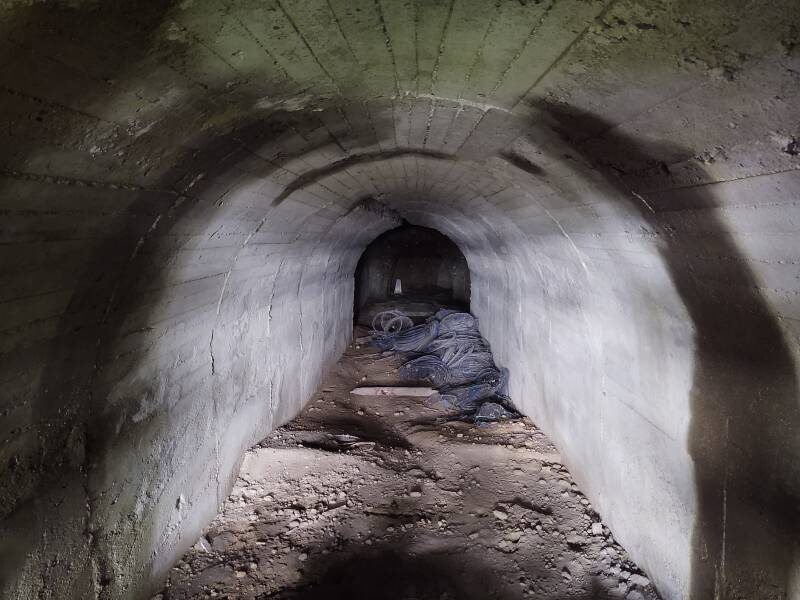
The only operational use of the Kaiten manned torpedo involved launches from the decks of submerged submarines. The first deployment in November 1944 led to the destruction of the Cimarron-class oiler USS Mississinewa, AO-59, with the loss of 63 of its crew of 299. Later missions sank a destroyer escort and an infantry landing craft, with a total of 187 U.S. dead.
The submarines that carried the Kaiten into battle couldn't safely observe what actually happened. Their officers listened for explosions and then submitted overly optimistic reports. The sinking of the USS Mississinewa was reported as the destruction of three U.S. aircraft carriers.
Meanwhile, the Kaiten was far more deadly to the Japanese than it was to its targets. 104 Kaiten pilots and 156 technical staff were killed in training and operational accidents. On top of that, eight submarines functioning as Kaiten carriers were sunk, killing 846 crewmen.
Why Were Suicide Torpedoes Used?
Cryptanalysis,Japan, and
the End of
World War II
I have far more detail on another page, but the relatively short version is:
The Allies could decrypt and read a significant amount of Axis messages. Japan's Army and Navy distrusted each other. The Army was home to the most extreme nationalists. None of the military trusted the Foreign Ministry and the diplomatic corps. Late in the war, Japan's Foreign Ministry saw that the military was leading the nation into what it expected to be total destruction. The Allies were reading most of this, but everything about cryptanalysis was highly classified and much remained so for decades. The fact that the U.S. was reading diplomatic traffic of Japan and other countries and continued to do so for decades after the war was classified into the 1990s.
Visiting theNormandy
Landing Beaches
The Allies were planning Operation DOWNFALL, the invasion of Japan's Home Islands. It would be in two parts. Operation OLYMPIC would be the invasion of Kyūshū in November 1945 with 14 divisions — one division each from the U.K., Canada, and Australia, and eleven divisions of U.S. troops. Then, in March 1945, Operation CORONET would have up to 40 divisions landing near Tōkyō. Compare the total of 54 divisions to the 12 divisions that landed in Normandy in June 1944. DOWNFALL would be four and a half times the scale of OVERLORD.
An Imperial Japanese Navy analysis had predicted up to 20 million Japanese deaths, which Japan's military leadership considered to be an acceptable loss. The U.S. Joint Chiefs of Staff initial estimate was for 25,000–46,000 U.S., deaths, but later estimates increased that to 400,000–800,000.
In early 1945, famine throughout Japanese-controlled areas of Southeast Asia was killing several tens of thousands of people every month. Hunger and malnutrition were becoming more common in the Home Islands.
The desperate, doomed defense of the Home Islands was going to be one enormous suicide mission for the population of Japan. Suicide torpedoes and suicide divers walking across the sea floor were just parts of that.
Japan's leadership was obviously going to be prosecuted for war crimes. They had directed widespread summary execution, torture, and general mistreatment of prisoners of war and citizens in occupied territories. Hideous "medical" experiments had been carried out on prisoners of war and civilian populations. Knowledge and approval of these programs went all the way up the chain of command. The Emperor wasn't personally planning war crimes, but he certainly was aware of them and approved.
Jornada del muerto and the Trinity SiteThe Allied called for Japan's unconditional surrender with the Potsdam Declaration of 26 July 1945, issued ten days after the successful test of the first nuclear weapon. Japan was warned to surrender or face "prompt and utter destruction". Japan's leaders ignored the warning. Reading both military and diplomatic traffic, the Allies saw that Japan's leadership understood the warning, and accurately anticipated the effects of an Allied invasion.
The U.S. dropped one nuclear bomb each on Hiroshima and Nagasaki on 6 and 9 August, 1945. One overnight incendiary bombing raid on Tōkyō in March had killed more people and completely destroyed a larger area than the Hiroshima and Nagasaki bombs combined. But the new bomb was far more powerful. One bomb could destroy much of a city.
The cries of "Japan is a victim of U.S. atrocities" began immediately. Japan's surviving leadership and population were terrified that the Emperor would be tried for war crimes, and possibly convicted and executed.
The identity and existence of the Japanese nation was conflated with the person of the Emperor. As the descendant of the gods who created the universe, his execution for war crimes would mean the end of Japan, the end of humanity, and really the end of the universe.
The post-Occupation Japanese government funded a public relations effort to portray the two nuclear bombs as U.S. atrocities, with high spending continuing until Japan's economic crash in the late 1980s. The Soviet Union and the Warsaw Pact nations jumped on board the propaganda push, joined by the People's Republic of China and its sphere of influence,
Visiting the Tateyama Air Defense Bunker at NagasakiThe fact that the Allies were reading both military and diplomatic Japanese traffic remained classified, some of it not being made public until the mid 1990s, and more is probably still classified or now lost to history. The U.S. had realized that the first nuclear bomb was necessary, and then the second if Japan did not respond. Otherwise, millions would die while the war continued for at least another year.
The most sensitive secrets had to do with how both Germany and Japan had made some simple, easily avoided errors in key selection and the operation of their cipher systems. If they had used their systems in more secure ways, Allied cryptanalysis would have been far less successful.
The nearby Chiran air base, near the opening of Kagoshima Bay, was the launch point for hundreds of Kamikaze air missions during the final months of the war. But U.S. ships never approached the bay, and so this suicide torpedo facility saw no action.
On the night of 16–17 June 1945, 120 B-29s of the 314th Bombardment Wing of the U.S. Army Air Forces dropped 809.6 tons of incendiary and cluster bombs on Kagoshima City. Cloudy weather required some of the planes to navigate to the city and drop their bombs by radar. The imprecise area bombing still destroyed about 5.5 km2, 44% of the built-up area, and killed 2,316 people.
A New York Times article reported that General Curtis LeMay had announced the preceding week that B-29 raids "had knocked key cities — Tokyo, Yokohama, Nagoya, Osaka, and Kobe — out or nearly out of war production." Now the nightly incendiary raids shifted to smaller cities. That night's missions bombed Kagoshima and Omuta on Kyūshū, and Hamamatsu and Yokkaichi on Honshū. From the Times article:
Only two Japanese searchlights fingered the sky as leading elements of the B-29's in the four-way strike attacked Kagoshima. Although the overcast was heavy when later elements reached the city, violent flames glistened on the dropping bombs and were plainly visible to crewmen. Grayish smoke indicated to the crew of one Superfortress that a chemical plant had been hit. "I think we can write off Kagoshima, for the city was blazing right to the waterfront", reported Lieut. George Mott of East Tallassee, Ala., commander of the last plane over the target.
Further bombing raids struck Kagoshima during the following days. Seven weeks remained until the Hiroshima mission.
The 1863 Bombardment of Sakurajima
There's earlier naval history here.
In September, 1862, the British merchant Charles Lennox Richardson had disregarded repeated warnings to stay out of the way of the entourage of Shimazu Hisamitsu, the father and regent of the daimyo of Satsuma, the warlord controlling the area of Kagoshima City and Sakurajima.
Hisamitsu's retainers killed the merchant under a traditional law which allowed samurai to kill any disrespectful person of a lower social class. Westerners in Japan were outraged, because the "unequal treaties" in force at the time were intended to allow westerners to do as they pleased in Japan.
The British chargé d'affaires demanded that the Tokugawa shōgunate apologize and pay £ 100,000, roughly equivalent to one-third of the annual revenues of the entire Japanese government, or approximately £ 15,746,000 today. He also threatened a naval bombardment of Edo, the national capital (renamed Tōkyō after the Meiji Restoration), and made further demands for the arrest of the killers and further £ 25,000 compensation to surviving members of Richardson's party and to Richardson's relatives.
By the following summer, the national government had issued the apology and paid the £ 100,000. However, the Satsuma Domain refused to apologize, pay the additional £ 25,000, and arrest the two samurai involved.
The British chargé d'affaires passed along orders from the British government, directing Royal Navy warships to force the Satsuma Domain to comply. A squadron of seven British warships sailed south from Yokohama on 6 August, and arrived in Kagoshima Bay on the 11th.
After a few days, the Anglo-Satsuma War of 15–17 August 1863, less dramatically known as the Bombardment of Kagoshima, began in the bay between Kagoshima City and Sakurajima. The British fleet seized three British-built Satsuma-owned merchant ships, with the ships and their cargo collectively worth about £ 200,000.
The Satsuma Domain evacuated the city, waited for a typhoon to arrive, and then began shelling the British ships from their coastal battery at today's ferry dock on Sakurajima.
The British confiscated all the material they could quickly remove from the merchant ships, and then set them on fire.
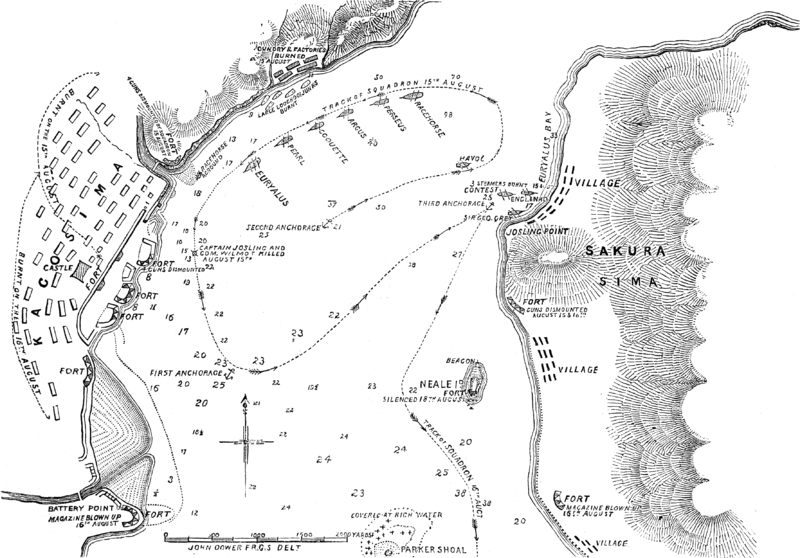
Map of the bombardment of Kagoshima from the 7 November 1863 Illustrated London News, from Wikimedia Commons. Josling Point in the above is just north of this bunker, with the ferry terminal just south of that. The 1914 eruption sent lava into the bay, covering Neale Island with lava and joining it to Sakurajima.
After two hours of preparation, the British ships formed a line of battle and sailed south along the shoreline, barraging Kagoshima and destroying about 500 houses, the embassy of the Ryukyu Kingdom, and five Ryukuan trading ships that happened to be in the way. Then they crossed the bay and continued firing on the Satsuma battery.

Eventually, the Satsuma guns were mostly put out of action. The British were running low on ammunition. Five Satsuma men had been killed. Thirteen British were dead, including the captain and his second-in-command on the HMS Euryalus, both of them decapitated by the same cannonball. The British fleet retreated.
The Satsuma Domain decided that it was their victory. The British had not landed marines or taken away the Satsuma cannons, the usual indicators of naval victory, and the British had suffered 2.6 times the fatalities of the Satsuma side.
It was a face-saving outcome for the Satsuma Domain. They borrowed the £ 25,000 from the Tokugawa Shōgunate, which was soon replaced by the Meiji Government and so Satsuma never had to repay the loan. They didn't arrest, didn't even identify the samurai who killed Richardson, but the payment was enough that Britain soon signed a treaty with the Satsuma Domain to sell them steam-powered warships.

Britain became the Satsuma Domain's ally in the Boshin War, the Japanese Civil War that fully ended the Tokugawa Shōgunate and put the Emperor fully in charge. Prince Mutsuhito succeeded his father, Emperor Kōmei, in 1867, becoming the Meiji Emperor at the age of 14. The next year he moved the Imperial court north from Kyōto to Edo, which he renamed Tōkyō. The feudal han system was abolished in 1871, most of the daimyōs retired from public life, and most of the privileges of the samurai were abolished. Many Satsuma civil servants and businessmen took positions with the Meiji Government.
Visiting the Shrine of Tōgō HeihachirōA 15-year-old Tōgō Heihachirō had been manning one of the Satsuma guns. He went on to become one of Japan's greatest naval heroes, commanding the fleet that defeated the Imperial Russian Navy's fleet in the Russo-Japanese War of 1904-1905. He did not want to be posthumously declared to be a Shintō kami, one of thousands of vaguely defined deities, but that became his fate. Now you can visit his shrine in Tōkyō.
The Last Samurai
Saigō Takamori was born in Kagoshima. He was one of the "Three Great Nobles" who led the Meiji Restoration. But then he turned against the young Emperor.
He returned to Kagoshima, followed by many now-unemployed samurai or rōnin. The former samurai founded a private military academy, the Shi-gakkō, and soon dominated the Kagoshima government.
The new Meiji Government became alarmed, and sent warships to Kagoshima in January 1877 with orders to remove the weapons from the local arsenal. But before government troops could move into action, fifty students from the new academy attacked one of the arsenals and carried off all the weapons. Over the next three days, over a thousand students raided other arsenals and the naval yards.
Saigo was forced out of retirement to lead the Satsuma Rebellion against forces of a national government — military forces Saigo had helped to modernize, commanded by a government he had helped to place in power.
Saigō was leading a force of 12,000 infantry and 60 artillery pieces, marching north through Kyūshū with plans to march all the way to Tōkyō. They faced 51,800 troops in the Imperial army, over 5,000 Imperial guardsmen, and 18,000 militarized police.
Saigō's forces were soon reduced to 3,000 who had lost all of their artillery and most of their modern firearms. Saigō and his last 500 men slipped out of the Imperial encirclement and retreated to Kagoshima.
Imperial forces soon arrived. They outnumbered Saigō's 60 to 1. Saigō still would not surrender. The Imperial forces carefully prepared while warships in Kagoshima harbor shelled Saigō positions. The final government assault began early on 24 September 1877. Saigō was severely wounded in the hip or thigh and only 40 of his men were alive by 0600. Saigō died, the last of his men drew their swords and charged downhill toward the well-fortified Imperial positions, and that was the end of the rebellion and the samurai. The Imperial government was almost bankrupt, but it had put down the rebellion while demonstrating the effectiveness of a modern military.
The government was forced to sell state-owned enterprises such as manufacturing and mining, basically everything except the railroad, the telegraph network, and the military industries, to politically-connected merchants and former government officials. For very low prices, those men formed the initial zaibatsu, large multi-component industrial firms.
Supporters of the rebellion led by Saigō formed right-wing ultra-nationalist groups, some in the form of secret societies, some of which evolved into paramilitary organizations that remained active through World War II.
Exactly how did Saigō die? There were no eyewitness reports. The dominant legend is that he performed seppuku or ritual suicide. Someone performing seppuku traditionally has a second to immediately cut off their head if the self-inflicted stomach wound isn't working. Possibly that's what happened. Many historians say that he very likely lost consciousness due to blood loss from the leg or hip wound, and one or more of his remaining samurai beheaded him and reported that it had been successful seppuku, warrior's suicide.
Some, however, insisted that Saigō had successfully fled to Russia or even ascended to Mars. The legends persisted and grew, with some claiming that his image appeared in a comet in the late 1800s. The Meiji government pardoned him posthumously, in February 1889.
The story of Saigō's supposed suicide was incorporated into the rise of bushidō or "the way of the warrior" as a national ideology in the early 1900s. It became accepted as part of Japanese history, and was incorporated into the rising nationalism. For details, see "The Apocryphal Suicide of Saigō Takamori: Samurai, Seppuku, and the Politics of Legend" (Mark J Ravina, The Journal of Asian Studies, 69(3), August 2010, pp 691-721, doi:10.1017/S0021911810001518).
A statue of Saigō in hunting garb with his dog was unveiled in Ueno Park in Tokyo in 1898. It's at the south end of the park, close to the train station, and is still quite popular.
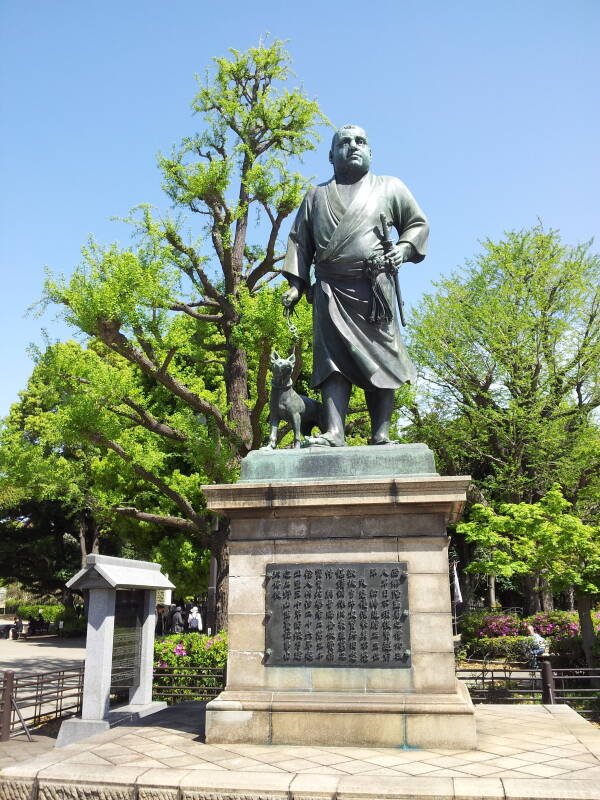
Other topics in Japan:
